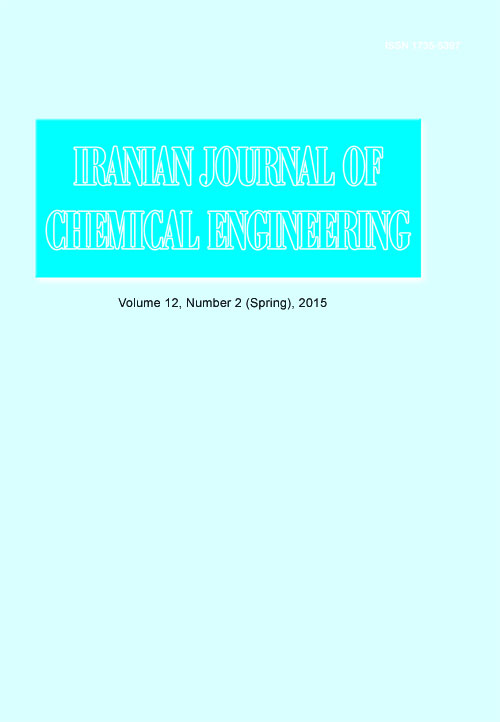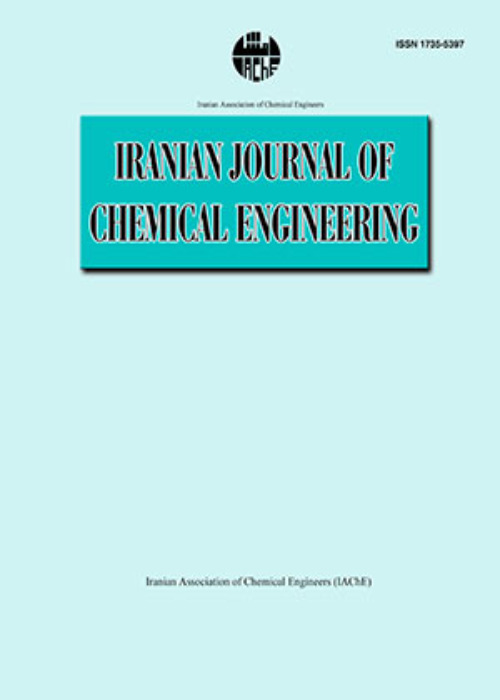فهرست مطالب

Iranian journal of chemical engineering
Volume:12 Issue: 2, Spring 2015
- تاریخ انتشار: 1394/07/16
- تعداد عناوین: 8
-
-
Pages 3-12Copper-silica aerogel was synthesized by the sol-gel method and was heated at 400, 500 and 600°C for 3 h in the air. The gained materials were named as sample (a), (b) and (c) respectively. Then all samples were characterized by FE-SEM, EDX and FTIR spectroscopy. For resistance measurements the pulverized material was pressed to form a disk-type sensor. The measurements of resistance in the relative humidity range of 11.3-84.3% were performed for all samples. For the following experiments sample (a) was chosen. Then the response time and stability properties were examined. The response time of 7.5 minutes was obtained and the stability graphs showed that in the higher RH the sensor was more stable.Keywords: Humidity Sensor, Silica Aerogel, Electrical Properties, Copper, Silica Composite, Resistance Measurements
-
Pages 13-25Despite numerous studies of shell and helically coiled tube heat exchangers, a few investigations on the heat transfer and flow characteristic consider the geometrical effects like coil pitch. Moreover, this scarcity is highlighted for the shell side of this type of heat exchangers. This study reports experimental and Computational Fluid Dynamics (CFD) investigations on heat transfer and flow characteristics of a shell and helically coiled tube heat exchanger. The experiments were carried out using a helically coiled tube, which was placed in a cylindrical shell. Hot and cold water were used as the process fluids on the tube and shell side, respectively. The CFD modeling technique was employed to describe the experimental results, fluid flow pattern, and temperature profiles as well as dead zones in the heat exchanger. Quantitative predicted results of CFD modeling show a good agreement with the experimental data for temperature. The effect of the coil pitch on heat transfer rate was numerically studied and it was found that the heat transfer coefficient intensifies with an increase in coil pitch. The average turbulent kinetic energy (k) for the old coil tube and twice coil pitch heat exchanger was computed as 2.9×10-3 and 3.3×10-3 m2/s2, respectively. This indicates an increase of about 14% in flow turbulent kinetic energy. Nusselt numbers were compared with those estimated using published correlation and a mean relative error (MRE) of 14.5% was found between the experimental and predicted data. However, a good agreement was obtained in lower shell Reynolds numbers (lower than Re=200).Keywords: Heat Exchanger, Helically Coiled, Shell Side, Computational Fluid Dynamics (CFD), Modeling
-
Pages 26-36In this paper, extraction of starch and protein from potato during leaching in a batch extractor, using distilled water as the solvent, was investigated. The experiments were carried out by soaking bulk of infinite slab shape potato samples in distilled water in a temperature and agitation controlled batch extractor at the three temperatures of 30, 45 and 55ºC. A mathematical model was developed for prediction of mass transfer during the leaching process, by defining a partition factor (K) as the ratio of the concentration on the surface of the body to that in the bulk of solution. Diffusion coefficients of the solutes and moisture were obtained by fitting the experimental data of solute loss and moisture gain to the first six terms of the series solution of the mathematical model by using a non-linear regression analysis. The diffusivity values for starch, protein and moisture were evaluated between 0.27310-10 and 1.57710-10 m2/s, with adjustment parameter R2 values in the range of 0.941 to 0.986 and mean relative error (MRE) values between 0.092 and 0.356, respectively. Results showed that the proposed model could be used for explaining the diffusion of solutes and moisture into the potatoes, during the leaching process, with acceptable degree of goodness.Keywords: Leaching, Extraction, Partition Factor, Potato, Starch
-
Pages 37-49The computational fluid dynamics (CFD) simulations of gas turbine combustor were performed for CH4/air flow with swirl flames. The flow dynamics and velocity fields were numerically studied and the results compared with the experimental data obtained by laser measurements. Two-dimensional (2D) and three-dimensional (3D) simulations were performed with consideration of a two-step oxy-combustion reaction kinetics model. The Eddy Dissipation Concept (EDC) combustion model was used in the numerical analysis. The numerical results obtained by EDC model were in good agreement with the experimental data. However, an error analysis showed that the simulated mean velocity components obtained by 3-D geometry were more consistent with the experimental data than those obtained by 2-D geometry.Keywords: Gas Turbine, Combustion, CFD Simulation, Flow Dynamics, Velocity fields
-
Pages 50-58Long-chain alkanes are a major constituent of crude oils and their conversions into other compounds are of interest depending on the specific application. Here, five native microbial consortia obtained from petroleum polluted sites were examined for biological conversion of n-octadecane as a representative of long chain alkanes. The experiments were implemented in 250 mL flasks containing 0.5 g n-octadecane in 40 mL culture media kept on a shaker at 160 rpm and 30C for one week. A pure culture of Psedumonas putida was inoculated at the same condition for comparison. Amongst the consortia, ABN52 imposed more obvious changes on n-octadecane. The GC-MS analysis of daily samples showed the appearance of lighter branched compounds at the first and second days of incubation but disappeared in the following days. At the end of incubation time up to 20 (w/w%) of the initial substrate was turned into polyhydroxyalkanoates (PHAs). It also suggested higher activity of the consortia compared to the pure culture of Psedumonas putida.Keywords: Bioconversion, Aalkanes, Polyhydroxyalkanoate, PHA, Pseudomonas Putida
-
Pages 59-74The adsorption behavior of three amphiphilic ionic liquids (ILs), 1-alkyl-3-methylimidazolium chloride {[Cnmim][Cl], n=6-8}at the interface of n-butyl acetate + water system was studied with IL concentration range of 1.00×10-4-1.00×10-1 mol•dm-3 and temperature range of 293.2-318.2 K. The ILs behave as strong surfactants in this chemical system and significantly reduce the interfacial tension with the order of their alkyl chain length and is consistent with their hydrophobicity nature. An almost linear decrease of interfacial tension with temperature was also relevant. The experimental data were satisfactorily reproduced with Szyszkowski equation, implying an ideal ILs adsorption. In this regard, the Langmuir maximum interface excess and equilibrium adsorption constant were obtained at different temperatures for each IL. Accordingly, effectiveness of adsorption and adsorption tendency increase with the alkyl chain length. At the saturated interface, increasing temperature leads to declining Langmuir maximum interface excess due to disrupting surrounding water molecules around ILs hydrophobic portions. However, adsorption tendency of ILs increases slightly with temperature.Keywords: Ionic Liquids, Alkyl Chain Length, Interfacial Tension, Szyszkows kiequation, Ideal Adsorption
-
Pages 75-87The effective parameters on Ohmic heating in static system containing biosolid-water were studied. The effects of distribution of particles, salinity and electric field strength on electrical conductivity, profiles of temperature, heat generation have been investigated.The experimental data verification with simulation results using computational fluid dynamics (CFD) method were carried out. Governing equations (heat transfer and electrical equations) were discretized with finite element method.The experimental data and CFD results showed that in Ohmic heating process, the current diffusion in all the products is faster than traditional methods and the diffusion rates are equal for both biosolid-liquid phases.Keywords: Ohmic Heating, Biosolid, Liquid, CFD, Electrical Conductivity, Salinity, Electrical Field Strength
-
Page 88


